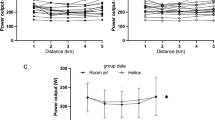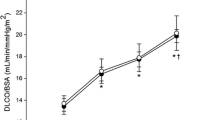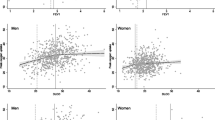Abstract
Aging related changes in pulmonary function may make older women (OW) more susceptible to expiratory flow limitation (EFL) and lead to higher dyspnoea ratings during exercise relative to young women (YW). Accordingly, the purpose of this study was to compare sensory responses and EFL susceptibility and magnitude in 8 YW (29 ± 7 years) and 8 healthy OW (64 ± 3 years) matched for percentage-predicted forced vital capacity (% predicted FVC) and % predicted forced expiratory volume in 1 s. EFL was calculated as the percent overlap between tidal flow–volume loops during maximal exercise and the maximal expiratory flow–volume (MEFV) curve. Peak oxygen consumption (V′O2peak) was lower in the OW compared to the YW (29.4 ± 3.6 vs. 49.1 ± 8.9 ml kg−1 min−1, P < 0.05) as was maximal ventilation (73.7 ± 18.4 vs. 108.7 ± 14.1 l min−1, P < 0.05). EFL at maximal exercise was present in 2 of 8 YW and in 5 of 8 OW. There were no significant differences in the magnitude of EFL between OW (23 ± 24, range: 0–69 %EFL) and YW (9 ± 18, range: 0–46 %EFL, P = 0.21). The magnitude of EFL in OW was inversely related to % predicted FVC (r = −0.69, P = 0.06), but this relationships was not observed in the YW (r = −0.23, P = 0.59). The OW consistently reported greater dyspnoea and leg discomfort for any given absolute work rate, but not when work was expressed as a percentage of maximum. Reduced ventilatory and exercise capacities may cause OW to be more susceptible to EFL during exercise and experience greater dyspnoea relative to YW for a standardized physical task.




Similar content being viewed by others
References
American Thoracic Society, European Respiratory Society (2002) ATS/ERS statement on respiratory muscle testing. Am J Respir Crit Care Med 166:518–624
American Thoracic Society (1999) Dyspnea. Mechanisms, assessment, and management: a consensus statement. Am J Respir Crit Care Med 159:321–340
Babb TG, Rodarte JR (2000) Mechanism of reduced maximal expiratory flow with aging. J Appl Physiol 89:505–511
Beidleman BA, Rock PB, Muza SR, Fulco CS, Forte VA, Cymerman A (1999) Exercise VE and physical performance at altitude are not affected by menstrual cycle phase. J Appl Physiol 86:1519–1526
Bemben DA, Salm PC, Salm AJ (1995) Ventilatory and blood lactate responses to maximal treadmill exercise during the menstrual cycle. J Sports Med Phys Fitness 35:257–262
Borg GAV (1982) Psychophysical bases of perceived exertion. Med Sci Sports Exer 14:377–381
Canadian Society for Exercise Physiology (2002a) PAR-Q and you. Canadian Society for Exercise Physiology, Ottawa, ON
Canadian Society for Exercise Physiology (2002b) PARmed-X and you. Canadian Society for Exercise Physiology, Ottawa, ON
Derchak PA, Stager JM, Tanner DA, Chapman RF (2000) Expiratory flow limitation confounds ventilatory response during exercise in athletes. Med Sci Sports Exerc 32:1873–1879
De Souza MJ, Maguire MS, Rubin KR, Maresh CM (1990) Effects of menstrual phase and amenorrhea on exercise performance in runners. Med Sci Sports Exerc 22:575–580
Dempsey JA, Miller JD, Romer LM (2006) ACSM’s advanced exercsise physiology, Chap 10. In: Tipton C (ed) The respiratory system. Lippincott Williams & Wilkins, Baltimore, p 270
Dominelli PB, Guenette JA, Wilkie SS, Foster GE, Sheel AW (2011) Determinants of expiratory flow limitation in healthy women during exercise. Med Sci Sports Exer 43(9):1666–1674
Enright P, Kronmal R, Manolio T, Schenker M, Hyatt R (1994) Respiratory muscle strength in the elderly. Correlates and reference values. Cardiovascular Health Study Research Group. Am J Respir Crit Care Med 149:430–438
Frank NR, Mead J, Ferris BG (1957) The mechanical behavior of the lungs in healthy elderly persons. J Clin Invest 36:1680–1687
Frontera WR, Hughes VA, Fielding RA, Fiatarone MA, Evans WJ, Roubenoff R (2000) Aging of skeletal muscle: a 12-yr longitudinal study. J Appl Physiol 88:1321–1326
Guenette JA, Dominelli PB, Reeve SS, Durkin CM, Eves ND, Sheel AW (2010) Effect of thoracic gas compression and bronchodilation on the assessment of expiratory flow limitation during exercise in healthy humans. Respir Physiol Neurobiol 170:279–286
Guenette JA, Witt JD, McKenzie DC, Road JD, Sheel AW (2007) Respiratory mechanics during exercise in endurance-trained men and women. J Physiol 581:1309–1322
Hankinson JL, Odencrantz JR, Fedan KB (1999) Spirometric reference values from a sample of the general US population. Am J Respir Crit Care Med 159:179–187
Harms CA, Wetter TJ, St Croix CM, Pegelow DF, Dempsey JA (2000) Effects of respiratory muscle work on exercise performance. J Appl Physiol 89:131–138
Jensen D, Ofir D, O’Donnell DE (2009) Effects of pregnancy, obesity and aging on the intensity of perceived breathlessness during exercise in healthy humans. Respir Physiol Neurobiol 167:87–100
Johnson B, Badr MS, Dempsey JA (1994) Impact of the aging pulmonary system on the response to exercise. Clin Chest Med 15:229–246
Johnson B, Reddan WG, Pegelow DF, Seow KC, Dempsey JA (1991a) Flow limitation and regulation of functional residual capacity during exercise in a physically active aging population. Am Rev Respir Dis 143:8
Johnson B, Reddan WG, Seow KC, Dempsey JA (1991b) Mechanical constraints on exercise hyperpnea in a fit aging population. Am Rev Respir Dis 143:968–977
Johnson BD, Weisman IM, Zeballos RJ, Beck KC (1999) Emerging concepts in the evaluation of ventilatory limitation during exercise. Chest 116:488–503
Killian K, Summers E, Jones N, Campbell E (1992) Dyspnea and leg effort during incremental cycle ergometry. Am Rev Respir Dis 145:1339–1345
Klas J, Dempsey J (1989) Voluntary versus reflex regulation of maximal exercise flow: volume loops. Am Rev Respir Dis 139:150–156
McClaran SR, Babcock MA, Pegelow DF, Reddan WG, Dempsey JA (1995) Longitudinal effects of aging on lung function at rest and exercise in healthy active fit elderly adults. J Appl Physiol 78:1957–1968
McClaran SR, Harms CA, Pegelow DF, Dempsey JA (1998) Smaller lungs in women affect exercise hyperpnea. J Appl Physiol 84:1872–1881
McClaran SR, Wetter TJ, Pegelow DF, Dempsey JA (1999) Role of expiratory flow limitation in determining lung volumes and ventilation during exercise. J Appl Physiol 86:1357–1366
Mead J (1980) Dysanapsis in normal lungs assessed by the relationship between maximal flow, static recoil, and vital capacity. Am Rev Respir Dis 121:339–342
Mota S, Casan P, Drobnic F, Giner J, Ruiz O, Sanchis Jn, Milic-Emili J (1999) Expiratory flow limitation during exercise in competition cyclists. J Appl Physiol 86:611–616
Niewoehner DE, Kleinerman J (1974) Morphologic basis of pulmonary resistance in the human lung and effects of aging. J Appl Physiol 36:412–418
Ofir D, Laveneziana P, Webb KA, Lam Y-M, O’Donnell DE (2008) Sex differences in the perceived intensity of breathlessness during exercise with advancing age. J Appl Physiol 104:1583–1593
Polkey M, Harris M, Hughes P, Hamnegard C, Lyons D, Green M, Moxham J (1997) The contractile properties of the elderly human diaphragm. Am J Respir Crit Care Med 155:1560–1564
Rowell LB, Shepherd JT (1996) Handbook of physiology, Sect 12. In: Society AP (ed) Exercise: regulation and integration of multiple systems. Oxford University Press, New York, p 1210
Sheel AW, Guenette JA, Yuan R, Holy L, Mayo JR, McWilliams AM, Lam S, Coxson HO (2009) Evidence for dysanapsis using computed tomographic imaging of the airways in older ex-smokers. J Appl Physiol 107:1622–1628
Tanaka H, Monahan KD, Seals DR (2001) Age-predicted maximal heart rate revisited. J Am Coll Cardiol 37:153–156
Taylor HL, Buskirk E, Henschel A (1955) Maximal oxygen intake as an objective measure of cardio-respiratory performance. J Appl Physiol 8:73–80
Tessier JF, Nejjari C, Letenneur L, Filleul L, Marty ML, Gateau PB, Dartigues JF (2001) Dyspnea and 8-year mortality among elderly men and women: the PAQUID Cohort Study. Eur J Epidemiol 17:223–229
Turner JM, Mead J, Wohl ME (1968) Elasticity of human lungs in relation to age. J Appl Physiol 25:664–671
Younes M, Kivinen G (1984) Respiratory mechanics and breathing pattern during and following maximal exercise. J Appl Physiol 57:1773–1782
Acknowledgments
We thank our subjects for their enthusiastic participation. This study was supported by the Natural Science and Engineering Research Council of Canada (NSERC) and the British Columbia Lung Association. J. A. Guenette was supported by graduate scholarships from the NSERC, the Michael Smith Foundation for Health Research (MSFHR) and the Sir James Lougheed Award of Distinction and has received post doctoral fellowships from NSERC, the John Alexander Stewart Fellowship (Queen’s University), the Canadian Thoracic Society and the Canadian Lung Association. S. S. Wilkie was supported by a Canada Graduate Scholarship from NSERC. A.W. Sheel was supported by a New Investigator award from the Canadian Institutes for Health Research.
Conflict of interest
None.
Author information
Authors and Affiliations
Corresponding author
Additional information
Communicated by Susan A. Ward.
Rights and permissions
About this article
Cite this article
Wilkie, S.S., Guenette, J.A., Dominelli, P.B. et al. Effects of an aging pulmonary system on expiratory flow limitation and dyspnoea during exercise in healthy women. Eur J Appl Physiol 112, 2195–2204 (2012). https://doi.org/10.1007/s00421-011-2191-x
Received:
Accepted:
Published:
Issue Date:
DOI: https://doi.org/10.1007/s00421-011-2191-x




